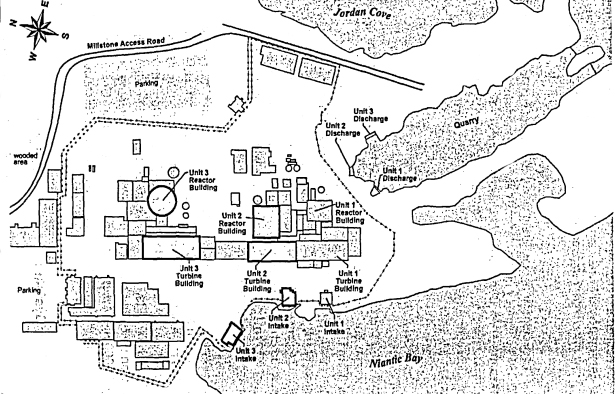The History of the Millstone Nuclear Power Plant
Connecticut has a complicated history with nuclear energy. Millstone power plant in Waterford is a major supplier of low-carbon electricity in both Connecticut and New England. But the facility has also generated strong opposition since it opened in 1970 from citizen and environmental groups concerned about its environmental, security, and public health risks. As the Governor's Council on Climate Change considers how to reduce statewide emissions, it must decide the role nuclear will play in the state's transition to a low-carbon economy.
In the 1960s and early 1970s, New England experienced a building boom in nuclear energy. Five facilities became operational in a decade in Massachusetts, Connecticut, Vermont, and Maine, and the construction permits for a sixth was approved in New Hampshire. (A partial nuclear meltdown in Three Mile Island in Pennsylvania in 1979 intensified the public's concerns about health and safety risks, slowing the boom, but the plants that were built during that time would shape New England energy for decades.)
Millstone Power Station, built in Waterford, Conn., began operations in 1970. The plant was named for the historic granite quarry that originally stood on the site, producing millstones and building stones for two centuries. Millstone's Unit 1 generated nearly 660 megawatts of electricity for Connecticut and surrounding states. In 1975 and 1986, two additional units were added to the facility, turning it into the largest power generator in New England and the region's only multi-unit nuclear plant. Northeast Utilities (now known as Eversource Energy[1]) owned and operated the site.

[Credit: Nuclear Regulatory Commission]
In 1992, a nuclear engineer at the Millstone plant warned federal officials that the facility wasn't properly disposing its spent fuel rods and that its cooling systems were insufficient in the case of an emergency.[2] Four years later, in 1996, Unit 1 of the plant was permanently shut down by the U.S. Nuclear Regulatory Commission for safety violations. Units 2 and 3 were allowed to restart
Around the time that Millstone closed its first unit, escalating operating costs, stricter safety regulations, and decreasing oil and natural gas prices started threatening the financial viability of dozens of nuclear power plants nationwide. Connecticut's other nuclear station, Connecticut Yankee in Haddam Neck, closed its doors in 1996 after 29 years.[3] Maine Yankee shuttered in 1996, and Yankee Rowe in Massachusetts, New England's first nuclear station, closed in 1992. New England quickly went from being a nuclear energy stronghold to being reliant on fossil fuels such as coal and increasingly, natural gas.
As part of Connecticut's plan to deregulate its energy sector (for more details, see The State of Energy in Connecticut) near the turn of the 21st century, state legislators forced Northeast Utilities to break up its monopoly by auctioning off its power stations. The company could buy back its facilities by bidding on them, but it instead seized the opportunity to get out of the nuclear business. The company took a financial hit when federal investigators ordered the closure of its three units in the mid 1990s—upwards of $1 billion.[4] Millstone was valued at far less than what Northeast Utilities had invested in the station, between original construction costs and upgrades over the years.
In 2001, Virginia-based Dominion Energy, one of the nation's largest suppliers and transporters of energy, officially purchased Millstone Power Station from Northeast Utilities for $1.28 billion cash.[5] It bought Units 1 and 2 in their entirety (Dominion took over the decommissioning of Unit 1, which had been permanently shut down), and 93.47 percent of Unit 3. The rest of Unit 3 is owned by the Massachusetts Municipal Wholesale Electric Company (4.8 percent) and the Green Mountain Power Corporation (1.73 percent). The move was a strategic one for Dominion, helping them increase their total electricity generation by 10 percent and expand into the New England market.
Units 2 and 3 currently generate about 2,100 megawatts of electricity daily, enough to power about 500,000 homes, and account for nearly 50 percent of Connecticut's electricity production.


